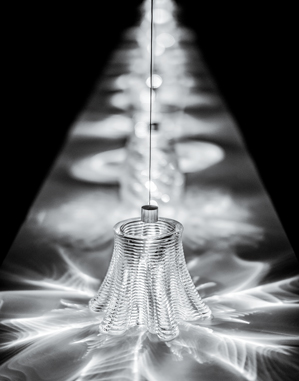Making Glass to Order
The technology of 3-D printing—which initially grew out of work at MIT—has been adapted in recent years to a wide variety of materials, including plastics, metals, and even food. Now a team of MIT researchers has opened up yet another new frontier: the ability to print optically transparent glass objects.

3-D-printed glass.
The new system was developed by Media Lab associate professor Neri Oxman, MIT Glass Lab director Peter Houk, graduate student John Klein, research affiliate Michael Stern, and others. They had to overcome a major obstacle: the extremely high temperature needed to melt the material. Others have tried to 3-D-print objects from tiny particles of glass melded together at a lower temperature in a technique called sintering, but such objects are structurally weak and optically cloudy, eliminating two of glass’s most desirable attributes: strength and transparency.
The high-temperature system developed by the MIT team retains those properties, producing objects that are both strong and fully transparent to light. Like other 3-D printers now on the market, the device can print, with little human intervention, designs created in a computer-assisted design program.
In operation, the new device’s feed hopper, and a nozzle through which the glass is extruded to form an object, are maintained at about 1,900 °F, far higher than the temperatures used for other 3-D printing. Glowing molten glass that has been gathered from a conventional glassblowing kiln resembles honey as it streams from the nozzle and coils onto a platform, cooling and hardening as it goes. The filament of glass needs to be kept hot enough to let the next layer of the structure adhere to it, but not so hot that the structure collapses.
The process could allow unprecedented control over the glass shapes that can be produced, Oxman says: “We can design and print components with variable thicknesses and complex inner features—unlike glassblowing, where the inner features reflect the outer shape.” This could allow printing of complex inner and outer surface features that would act as optical lenses.
Oxman also foresees the process being adapted to create much larger structures—even major portions of buildings. “Because glass is at once structural and transparent, it is relatively easy to consider the integration of structural and environmental building performance within a single integrated skin,” she says.
Keep Reading
Most Popular
Large language models can do jaw-dropping things. But nobody knows exactly why.
And that's a problem. Figuring it out is one of the biggest scientific puzzles of our time and a crucial step towards controlling more powerful future models.
The problem with plug-in hybrids? Their drivers.
Plug-in hybrids are often sold as a transition to EVs, but new data from Europe shows we’re still underestimating the emissions they produce.
Google DeepMind’s new generative model makes Super Mario–like games from scratch
Genie learns how to control games by watching hours and hours of video. It could help train next-gen robots too.
How scientists traced a mysterious covid case back to six toilets
When wastewater surveillance turns into a hunt for a single infected individual, the ethics get tricky.
Stay connected
Get the latest updates from
MIT Technology Review
Discover special offers, top stories, upcoming events, and more.